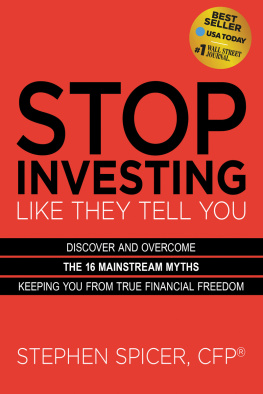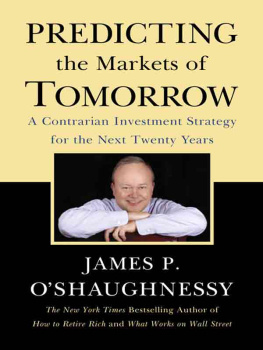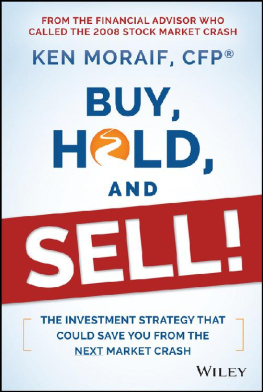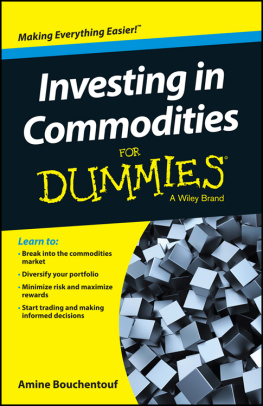
Cover design: Wiley
Copyright 2015 by Ken Moraif. All rights reserved.
Published by John Wiley & Sons, Inc., Hoboken, New Jersey.
Published simultaneously in Canada.
No part of this publication may be reproduced, stored in a retrieval system, or transmitted in any form or by any means, electronic, mechanical, photocopying, recording, scanning, or otherwise, except as permitted under Section 107 or 108 of the 1976 United States Copyright Act, without either the prior written permission of the Publisher, or authorization through payment of the appropriate per-copy fee to the Copyright Clearance Center, Inc., 222 Rosewood Drive, Danvers, MA 01923, (978) 750-8400, fax (978) 646-8600, or on the Web at www.copyright.com. Requests to the Publisher for permission should be addressed to the Permissions Department, John Wiley & Sons, Inc., 111 River Street, Hoboken, NJ 07030, (201) 748-6011, fax (201) 748-6008, or online at http://www.wiley.com/go/permissions.
Limit of Liability/Disclaimer of Warranty: While the publisher and author have used their best efforts in preparing this book, they make no representations or warranties with respect to the accuracy or completeness of the contents of this book and specifically disclaim any implied warranties of merchantability or fitness for a particular purpose. No warranty may be created or extended by sales representatives or written sales materials. The advice and strategies contained herein may not be suitable for your situation. You should consult with a professional where appropriate. Neither the publisher nor author shall be liable for any loss of profit or any other commercial damages, including but not limited to special, incidental, consequential, or other damages.
For general information on our other products and services or for technical support, please contact our Customer Care Department within the United States at (800) 762-2974, outside the United States at (317) 572-3993 or fax (317) 572-4002.
Wiley publishes in a variety of print and electronic formats and by print-on-demand. Some material included with standard print versions of this book may not be included in e-books or in print-on-demand. If this book refers to media such as a CD or DVD that is not included in the version you purchased, you may download this material at http://booksupport.wiley.com. For more information about Wiley products, visit www.wiley.com.
Library of Congress Cataloging-in-Publication Data:
Moraif, Ken.
Buy, hold, and sell! : the investment strategy that could save you from the next market crash / Ken Moraif.
pages cm
Includes index.
ISBN 978-1-118-95149-1 (hardback); ISBN 978-1-118-95151-4 (epdf);
ISBN 978-1-118-95150-7 (epub)
1. Investments. 2. Retirement income Planning. 3. Investment analysis. I. Title.
HG4521.M837 2015
332.6 dc23
2014036990
For my mom, who taught me how to save and invest, and made me who I am today.
Acknowledgments
I want to thank:
Money Matters' beloved and most valued clients.
The astute, inquisitive, and engaged listeners of my radio show.
The patient, long-suffering, and dedicated Cindy Brown, who put up with all of my quirks and calendar issues.
My three wonderful daughters, who never hesitate to criticize me and keep me on the straight and narrow.
And always, my beautiful, talented, and supportive wife Fay.
Introduction
One Bear Market Can Change Your Life Forever
How would you feel if you lost over 78 percent of your retirement investments in one bad market?
I'd been doing a weekly radio show for four years when I was asked to speak at the Managing Your Money conference in Arlington, Texas. After my presentation to some 4,000 attendees, I walked offstage to find a man in his late fifties waiting for me. He said, Ken, glad to meet you. I listen to your radio show every week.
Thanks, I said, shaking his hand.
Do you know how much money I had before this last bear market?
This was 2002. The tech bubble had recently burst. I was afraid this was going to be a sad story. No, I said, how much did you have?
Three million dollars.
Wow, that's great, I said. Congratulations.
Do you know much money I have now?
I shook my head, bracing myself.
I have $650,000.
I remember looking at the man. I couldn't believe he was standing, let alone smiling. But tell me, I said, To go from $3 million to $650,000, you had to see your investments drop to $2.5 million, then $2 million, then one and halfThere were signposts along the way. Why didn't you get off the ride?
And he said, I had every intention. I planned to get out if my investments ever dropped down to two and a half million. But when they went down that far, I thought to myself, I'm down $500,000. I can't sell now. That'd be ridiculous.
I had the feeling I knew where he was going.
He continued: So I drew a line in the sand: If my investments went down to $2 million, I'd sell for sure. But when they sank to that point, I did the same thing. I said to myself, Oh no, I'm down $1 million. I can't sell now, because the market will come back. I don't want to be the fool who sells at the bottom.
He went on. Everybody was telling me that the market was going to bounce back. I didn't want to miss the rebound. He shook his head. I never got out. I rode the market all the way to the bottom, and lost more than 70 percent of my money.
I wanted to say something encouraging to this poor guy, so I said, I admire your ability to smile. I meant it.
I could smile, or I could cry, he said. I choose to smile.
The Inspiration behind This Book
I don't want you to end up like that former millionaire. I want you to smile because you're playing with your grandkids, perfecting your golf game, or dancing on the beach with your spouse. I don't want you to have to go through the pain of losing the retirement you've earned. You worked hard, and you've looked forward to this time in your life. I want it to be the best time in your life. I want your retirement to be like your second childhood without parental supervision.
And I want to help you get there. I want to convince you of the need to buy, hold, and SELL. In today's financial world, you face volatile markets, huge deficits, and even the risks of governments going bankruptall of which add up to the possibility of huge losses. With those prospects, I think it's just plain irresponsible to simply ride the market. You need to have a proactive plan that includes a sell strategy.
But it's not easy. You've probably heard the same advice the unlucky investor followed. The market will come back. Don't be the fool who sells at the bottom. You don't want to miss the rebound. It's popular advice. If you Google investment advice, you'll probably find information that tells you to hold forever and just diversify. I've worked as a financial advisor since 1988, and have heard these buy-hold myths propagated on the investing public over and over again. Sometimes I've heard them from people like the man in the story; investors who believed in the myths that later destroyed their retirement dreams.
In Part One of this book, we'll discuss the reasons why buy-hold is a bad idea. In Part Two, we'll debunk the myths that may keep you from being proactive. In Part Three, we'll explore the ways to use a sell strategy. And we'll have some fun doing it along the way, with the help of a few of my favorite TV characters.
By understanding that most buy-hold recommendations are indeed myths, you'll be able to stand your ground when necessary. You'll be able to execute your sell strategy with confidence. You won't be just another placid sheep that blindly follows the rest of the flock right off a cliff.
Next page








